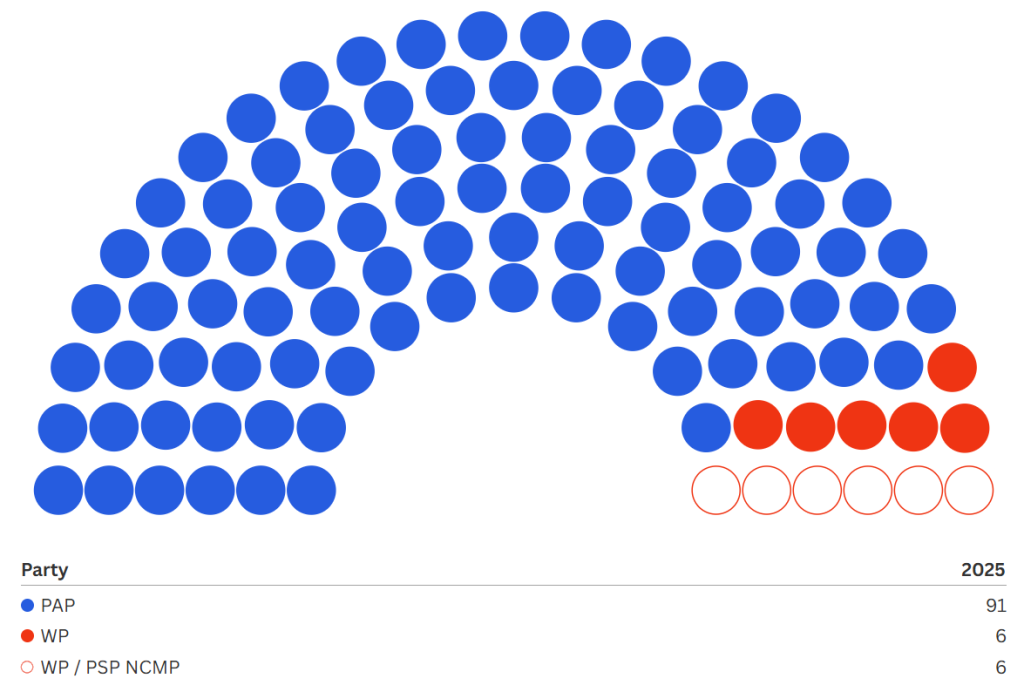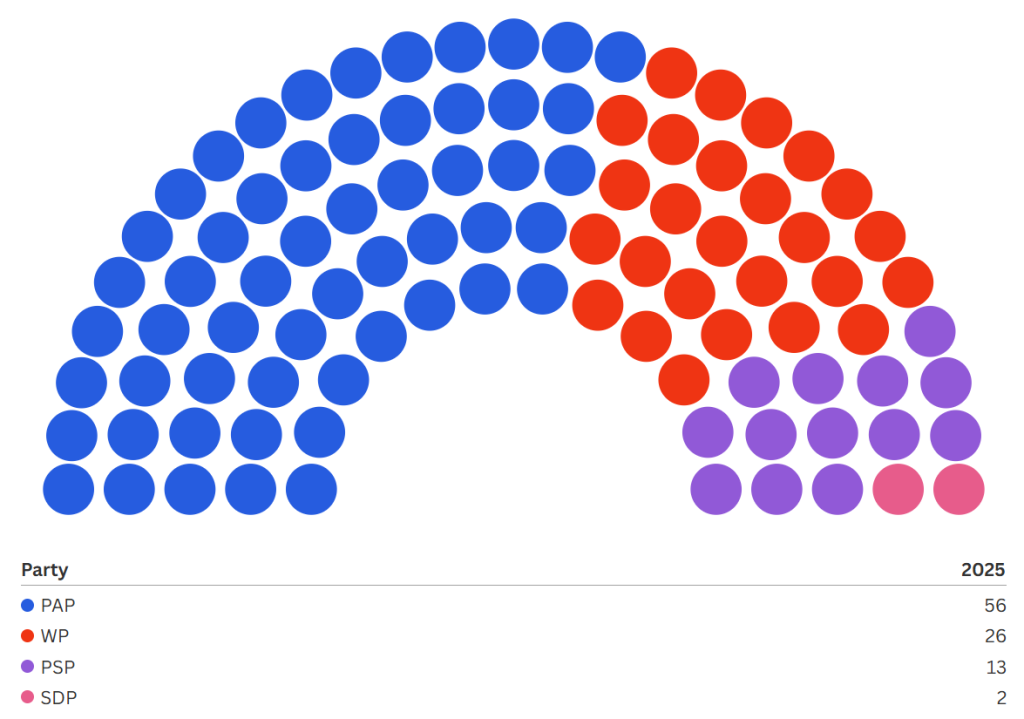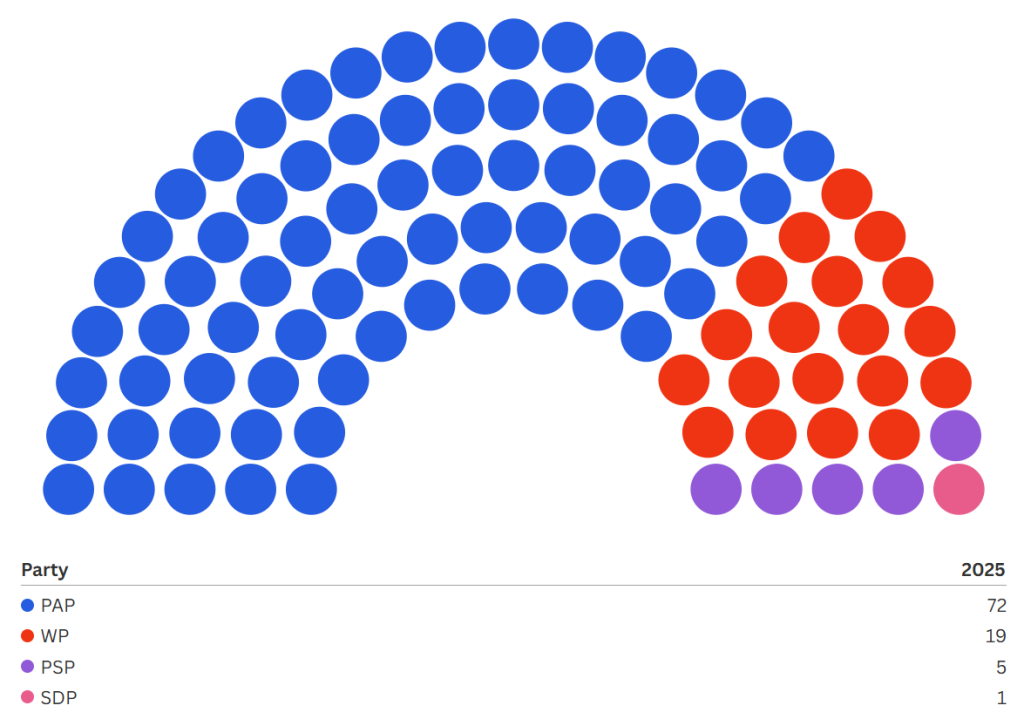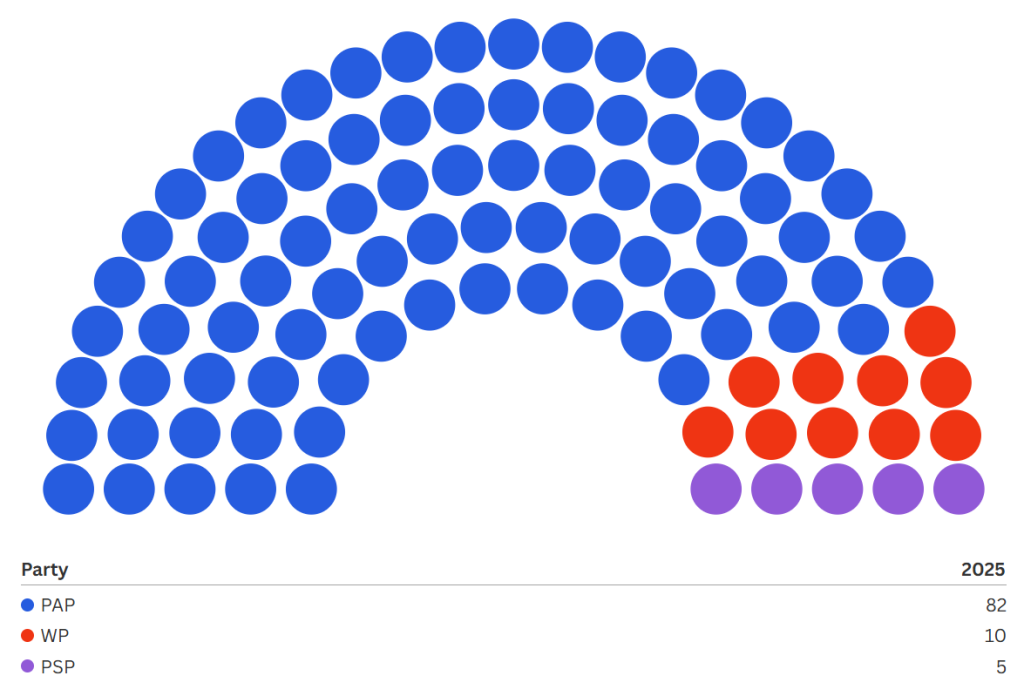What will the next parliament look like? Here are the most likely scenarios and distribution of seats
Disclaimer: Any opinions expressed below belong solely to the author.
The Singapore General Election campaign ends today with the cooling-off day following tomorrow and the final vote on Saturday. I have commented on electoral chances of candidates in specific constituencies in my articles published over the past few weeks, so in this final summary let’s take a look where it all leads.
What could the Singapore parliament look like on May 4? How many seats can the PAP win? How many electoral divisions can the opposition conquer? And how many parties will Singapore see in the parliament this term? Two? Three? Or maybe four?
Here’s where we start, the result of the General Election in 2020:
83 seats for the PAP, 10 for the Workers’ Party and additional 2 NCMPs from Progress Singapore Party of Tan Cheng Bock, for a total of 95 parliamentarians.
This year 97 seats are up for grabs in the election, though the final number of MPs will depend on the distribution of any potential NCMP slots.
The following analysis is based on the assumption that there are no more than four parties that can realistically compete for seats in Singapore parliament: PAP, WP, PSP and perhaps SDP. I do not want to dismiss other participants casually, but electoral success of any other party or independent candidate would be a major surprise to everyone.
Battlegrounds
As usual, the People’s Action Party is fielding candidates in all 33 constituencies. Their biggest rivals from the Workers’ Party are contesting eight of them, including two which are considered to be their safe, core areas: Aljunied GRC (5-member GRC) and Hougang SMC.
Here are the remaining six, each being a battleground to watch:
- Sengkang GRC (defended by WP)
- Punggol GRC
- Tampines GRC
- East Coast GRC
- Tampines Changkat SMC
- Jalan Kayu SMC
In total 20 seats are in contention in those electoral divisions.
PAP’s other major challenger is the Progress Singapore Party, which came very close to flipping West Coast GRC last time and received two NCMP seats in parliament for their effort.
This year the party is contesting 6 constituencies, including two GRCs and four SMCs, with a total of 13 seats. Its best chance is, once again, in the West, under a redrawn West Coast-Jurong West GRC – though they should not be counted out in other locations either.
In 2020 they were just upstarts on the local political scene but after five years in the parliament, with an outspoken current secretary-general Leong Mun Wai, their brand as something more than just Tan Cheng Bock’s pet project could resonate with voters in other places too. Here’s the complete list:
- West Coast-Jurong West GRC
- Chua Chu Kang GRC
- Bukit Gombak SMC
- Kebun Baru SMC
- Marymount SMC
- Pioneer SMC
Finally there’s the Singapore Democratic Party of Chee Soon Juan, which has been waiting nearly 30 years to return to the parliament after their complete defeat in 1997.
It is contesting 4 constituencies, two GRCs and two SMCs, with 11 seats. Realistically, however, the SMCs are the only two where they can hope to upset the PAP. Contesting Marsiling-Yew Tee and Sembawang GRCs against Lawrence Wong and Ong Ye Kung respectively is a tall order.
It’s no surprise then that Paul Tambyah and Chee Soon Juan chose more promising one-vs-one contests, as I explained before here. They’re running in:
- Bukit Panjang SMC
- Sembawang West SMC
where they won’t be facing any PAP ministers.
In total this adds up to 35 seats that the opposition can compete for with the PAP, plus six already considered safe in the hands of the Workers’ Party.
Electoral scenarios
1. PAP retakes Sengkang, restores its position from 2015
A dream scenario for the ruling party, which isn’t without chances in Sengkang this year. If it wants to take it back then now is the time, otherwise it may become another long-term WP-hold. PSP, weighed down by some of its own controversies from the past years, fails to flip the West Coast and the parliament sees a mix of very strong PAP and opposition divided in half into elected MPs and NCMPs

The parliament has 103 members as a result, given that NCMP scheme guarantees a minimum of 12 opposition voices in the chamber.
2. Opposition sweep – how would it look like?
We’ve looked at one end of the spectrum, now let’s look at the other – what would the parliament look like if opposition swept all of the seats it could even remotely contest? If WP and PSP win all of their constituencies, and SDP manages to put its two leaders in the parliament too:

In a 97 member parliament PAP would still command a strong majority of 57% of all seats, but below the margin needed to occasionally amend the Constitution. Just like the first scenario was their dream outcome, this is their nightmare.
It isn’t very likely but it is not outside of the realm of (remote) possibility.
3. Major opposition success
Now let’s consider at some more realistic outcomes, starting with what is reasonably achievable by the opposition this year.
Workers’ Party is hoping to defend Sengkang and extend its winning streak by taking at least one other GRC or even two. Their SMC chances don’t look quite as good as their challenge for Punggol, Tampines and East Coast.
If they win two of these they will grow their team by another 9 or 10 MPs.
On the opposite side of the island PSP hopes to finally win the West Coast, which would increase their presence in the parliament to full five members. This is an achievement well within their reach and one they have been preparing for. Finally, to call the GE a success, SDP would have to win at least one seat, given that NCMP scheme would no longer be applicable.
Here is how such a parliament would look like:

Such a result would, without doubt, be called a major success for the opposition. Adding three whole GRCs would end the NCMP scheme and their reliance on it. And while difficult, it is not something that couldn’t be reasonably considered before the vote.
4. WP stumbles, PSP flips
A more conservative look at the chances of all participants, bearing in mind that the Workers’ Party has had its share of controversies both during the last parliamentary term as well as during the ongoing campaign.
While it is able to put up a good fight in the constituencies contested, it’s not unlikely that it will stay where it is — controlling Aljunied, Hougang and keeping its Sengkang team as well.
Meanwhile, PAP’s West Coast GRC lineup, burdened by the fallout of S Iswaran scandal, is vulnerable to PSP’s challenge, which the latter could turn into a victory, making it a solid second opposition party in the parliament, with half the seats that WP has.

Given the fact that opposition’s progress has historically been quite slow, it would fit the pattern of them flipping one constituency at a time. Among those ripe for the taking West Coast-Jurong West GRC stands uniquely vulnerable given the scandal involving the former anchor minister, which not even slightly modified boundaries may be enough to offset.
That said, PAP is not without chances, of course, as justice was meted out, Iswaran was sent to prison and the second in command there, Desmond Lee, is a full minister too — and a young one, compared to the opposition team led by the 85 year old Tan Cheng Bock and 66 year old Leong Mun Wai.
Range of possible outcomes
Of course we could slice and dice the chamber in any number of alternative ways but these few examples are meant to illustrate the possibilities. Another way to look at them is simply by the range of seats each party is most likely to contest successfully, under the same conditions I set in the beginning (they are, of course, my own, entirely subjective opinion):
People’s Action Party
Broad range: 57 to 91 seats
Reasonable range: 71 to 87 seats
The ruling party can hope to fight WP back in Sengkang and defeat all other opposition parties, including PSP in the West Coast. It’s their dream outcome but not an unrealistic one given the past performance.
However, it could also lose as many as three to four GRCs. Besides West Coast, Tampines and East Coast look vulnerable, and Punggol seems to be a close race too, although PAP might have an edge there with DPM Gan Kim Yong and Sun Xueling duo.
Workers’ Party
Broad range: 6 to 26 seats
Reasonable range: 10 to 20 seats
The leading opposition party seems untouchable in Aljunied and Hougang. Defending Sengkang should also be doable, despite the Raeesah Khan scandal that left the constituency with an empty seat for the past four years.
On the other hand it should offer PAP a strong challenge in other GRCs and could win one or two of them this year, depending on how people weigh the scandals that rocked both the government and the opposition in the past year.
Progress Singapore Party
Broad range: 0 to 13 seats
Reasonable range: 0 to 5 seats
PSP will be trying to prove itself this year after its narrow loss in 2020. However, while the party could resist the PAP in all of its constituencies the only good chance it has at success is in its home division of West Coast.
If it fails to win it again there’s still the consolation prize of NCMP seats, assuming the Workers’ Party doesn’t win any other constituencies.
Singapore Democratic Party
Broad range: 0 to 2 seats
Reasonable range: 0 to 1 seat
Finally, SDP might be contesting 11 seats but all eyes are on Paul Tambyah and Chee Soon Juan. Both have their chances but the relocation of the latter, after Bukit Batok SMC disappeared after EBRC review, might undermine his chances.
Meanwhile, Paul Tambyah is back for a rematch in Bukit Panjang SMC, having lost by less than 7.5 per cent in 2020, and it wouldn’t be a shock to anybody if he succeeded in his challenge this year.
SDP might not be the favourite in either of the races but if it came out on top no one could say they didn’t see it coming.
What do the results really mean in Singapore?
As you can see the ruling party is still expected to hold a significant majority in the parliament and their most capable rivals can only gather enough candidates to contest around 40 seats out of 97 — realistically even fewer than that.
On the other hand, Singapore shouldn’t be evaluated by the same standards as any other democratic country. Here a loss of a single constituency by the PAP is considered a major event and a warning signal sent to the government. In other words — it means a lot more than simple math would suggest.
Which is why the government candidates have been campaigning quite intensively to secure the “strong mandate” for another five years, even though they are nearly certain to remain in charge.
At the end of the day, when sun rises on May 4, the government will still be run by the PAP but the scale of its victory is bound to influence its policies going forward.






